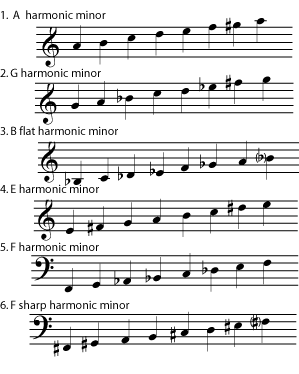
The natural minor scale consists of seven whole (W) and half (H) steps in the following succession: W-H-W-W-H-W-W. The minor scale most frequently used in tonal music from the Common Practice period is based on the aeolian mode (you’ll read more about modes later), which is sometimes referred to as the natural minor scale.

There are several scales that one might describe as minor, all of which have a characteristic third scale degree that is lower than the one found in the major scale.
DESCENDING NATURAL AND MELODIC MINOR SCALES ISO
The illustration below shows a D-major scale and corresponding ISO notation, scale degrees, and solfège syllables.Īnother scale with which you are likely very familiar is the minor scale. Scale degrees are labeled with Arabic numerals and carets (^). Solfège syllables, a centuries-old method of teaching pitch and sight singing, can also be used to represent scale degrees (when used in this way, this system is specifically called movable- do solfège). When described in this way, we call the notes scale degrees, because they’re placed in context of a specific scale. The pitch class A is the fifth note of the D-major scale. For example, the pitch class D is the first (and last) note of the D-major scale. While ISO notation allows us to label a pitch in its specific register, it is often useful to know where that pitch fits within a given scale. It is called the “D major scale” because the pitch D is the tonic and is heard at both ends of the scale. When the scale ascends, the tonic is repeated at the end an octave higher. The first pitch of the scale, called the tonic, is the pitch upon which the rest of the scale is based. Here is the chromatic scale that spans the pitches C4 through C5.Ī major scale, a sound with which you are undoubtedly familiar, consists of seven whole (W) and half (H) steps in the following succession: W-W-H-W-W-W-H. The chromatic scale consists entirely of half steps, and uses every pitch on the keyboard within a single octave. Usually, the pitches in a scale are each notated with different letter names, though this isn’t always possible or desirable. A whole step (W) consists of two half steps. A half step (H) consists of two adjacent pitches on the keyboard. There are two types of steps: half steps and whole steps.



When the scale is ascending, the scale degree numbers 6 and 7 are raised by a semitone/half step. The melodic minor scale consists of differing ascending and descending patterns. The seventh scale degree, or the leading note, is always raised by a semitone/half step, and it is always notated with an accidental, never in the key signature. The raised seventh degree, creating an augmented second between scale degrees 6 and 7, is what gives the harmonic minor its distinct sound. The semitones of a harmonic minor scale fall between scale degree numbers 2 – 3 5 – 6 and 7 – 8. The harmonic minor scale is defined by the interval pattern: The semitones fall between scale degree numbers 2 – 3 and 5 – 6. The natural minor scale is defined by the interval pattern: Though they each have different characteristics, tonal pieces in a minor mode will often draw on elements of each of these scales within the same piece. The harmonic and melodic minor scales are based on the natural minor scale but have differing chromatic alterations. The natural minor scale, as its name suggests, is a minor scale in its most natural state (with no alterations).
DESCENDING NATURAL AND MELODIC MINOR SCALES SERIES
Like major scales, minor scales also consist of a series of seven pitches, organised around a fundamental tonic. There are three common minor scales in use today: the natural minor, the harmonic minor and the melodic minor.


 0 kommentar(er)
0 kommentar(er)
